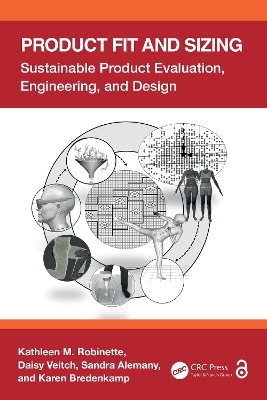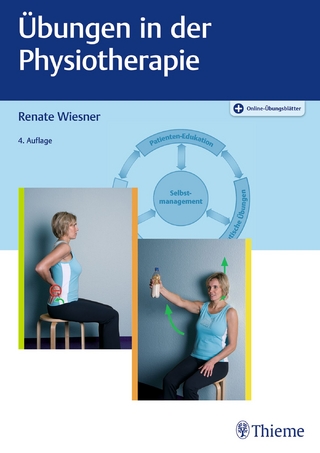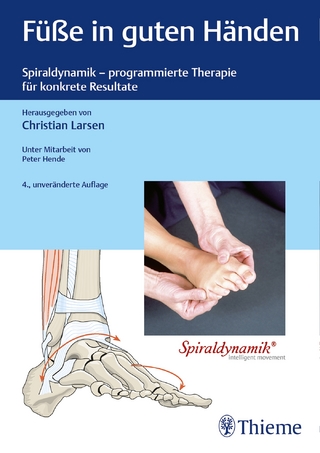
Product Fit and Sizing
CRC Press (Verlag)
978-1-032-49118-9 (ISBN)
In this book, for the first time, the complexity of assessing fit and using fittings in the product design process is addressed from a scientific and systems engineering perspective. It includes methods to represent the anthropometry of the target market, good practices to develop protocols for more reliable and consistent fit testing, methods for developing and maintaining a fit database, comprehensive statistical analyses needed for fit and sizing analysis, and instructions for selecting and modeling cases for new product development.
Product Fit and Sizing: Sustainable Product Evaluation, Engineering, and Design
offers step-by-step instructions for the evaluation, engineering, and design of existing and new products and includes real-world examples of mass-produced apparel, head wearables, and footwear products. It also explains how to develop a sustainable fit standard for fit and sizing continuity for all styles across all seasons and iterations.
This book is intended for industry professionals and undergraduate and graduate education to prepare students for design and engineering jobs. For organizations that purchase uniforms or protective equipment and apparel, it also provides instructions for purchasing professionals to evaluate the suitability of wearable products for their population.
The Open Access version of this book, available at http://www.taylorfrancis.com, has been made available under a Creative Commons Attribution-Non Commercial-No Derivatives (CC-BY-NC-ND) 4.0 license.
Kathleen M. Robinette, Ph.D., is a research consultant specializing in anthropometry, biostatistics, and fit and sizing for product development and assessment. She has more than 45 years’ experience, spearheading the development, management, and transitioning of new technologies in the field of engineering anthropometry, and led the field in the development of 3-D automated human scanning and modeling for product design and evaluation. She planned, organized, negotiated, and directed the first successful 3-D whole body human measurement survey (CAESAR), which produced more than 4,000 whole body models which continue to be used around the world today. She is a Fellow of the Air Force Research Laboratory from which she retired after 30 years of service and is an Honorary Fellow of the Human Factors and Ergonomics Society. She was Professor and Head of the Department of Design, Housing, and Merchandising at Oklahoma State University 2012-2015 and she established and directed the Human Factors department for Magic Leap Inc. 2015-2017 implementing fit mapping into the product development process. Kathleen has a Ph.D. in Biostatistics and Epidemiology from the University of Cincinnati, an M.S. in Mathematics/Statistics from Wright State University, and a B.A. in Anthropology from Wright State University. Daisy Veitch, Ph.D., is currently the Director of Anthropometry for Anthrotech Inc. and has served as an anthropometry and fit consultant for commercial apparel industry for more than 25 years. She worked with Flinders Medical Center to develop and refine 3D body scanning for medical applications. She is the owner of a US design patent and has registered designs in Australia, Europe, United States, and the European Community. She also directed the Australian National Size and Shape Survey in 2002. She worked in industry for ten years doing technical garment construction and serving as product engineer for an apparel company. As a recognized expert, she was appointed as an International Judge for APDeC 2013 (Asia Pacific Design Challenge) http://apdec.net. Daisy developed her fashion and design skills in Adelaide, Australia, beginning with the Australian Wool Corporation Young Designer Award and Queen Elizabeth II Silver Jubilee Award for Young Australians, which took her to Paris, France where she studied at the La Chambre Syndicale de la Couture Parisienne. She received her Ph.D. from TU Delft (Industrial Design Engineering with a specialization in Medisign). She is a founding member of World Engineering Anthropometry Resources (WEAR) and served as Treasurer and Secretary General. Sandra Alemany, Ph.D., is a research scientist at the Instituto de Biomecánica de Valencia (IBV) and founded the Anthropometry Research Group in 2015. She led large-scale anthropometry surveys in Europe using 3D scanning technology and has experience in applying anthropometry to improve wearable fit including: footwear, electronic devices, orthotics, insoles and clothing. Recent developments include a 4D body scanner in movement and the development of two mobile apps to generate 3D body shapes from photographs. She is an expert advisor on European Standardization Committees of Anthropometry and Size System of Clothing and an expert reviewer of R&D projects for the European Commission. She is currently serving as Co-chair for the Anthropometry Technical Committee for the International Ergonomics Association. She received her PhD. from the University Polytechnic of Valencia in 2023 with research about fit and clothing size prediction from anthropometry. Karen Bredenkamp currently heads up the Human Factors team at Magic Leap Inc. Karen has more than 20 years’ industry experience in anthropometry survey design, data collection, analysis, and implementation in wearable product and workstation design, as well as wearable product fit research as part of the product selection or development processes. Between 2000 – 2016 Karen was employed at Ergonomics Technology, a division of the Armaments Corporation of South Africa (ARMSCOR), where she had a core role in the establishment of the 3D whole-body and foot Anthropometry databases for the ethnically diverse and unique South African National Defence Force (SANDF) population. Her activities furthermore involved providing anthropometry and fit inputs and evaluation support for product design as well as purchasing of SANDF clothing, footwear, protective wearable products, workstations, and occupant environments. She also has worked in the transportation, mining and commercial industries. Karen is currently serving as Co-chair for the Anthropometry Technical Committee for the International Ergonomics Association. She has an MSc in Biomedical Engineering from the University of Cape Town and an BEng in Mechanical Engineering from Stellenbosch University, South Africa.
Chapter 1 Introduction 1
Abstract 1
Sustainable Product Evaluation, Engineering and Design Process (SPEED) 3
Inputs 6
Design loop 7
Sizing loop 8
How to use this book 13
Chapter 2 Inputs and Getting Started 16
Abstract 16
Products 17
Requirements and Constraints 17
Design Concept 21
Resources 24
Tools 24
Analysis & data management tools 25
Questionnaires 29
Anthropometry 35
Manual tool assessment 42
Imaging tool assessment 45
Physical fit measuring tools 57
Personnel and facilities 61
Personnel 61
Facilities 67
Use of human subjects 67
Test site considerations 68
Target population (TP) sampling and planning 70
Starting TP Sample 71
Planning full TP sample 77
Weighting samples 84
What can go wrong 86
Chapter 3 Cases and Fit Models 91
Abstract 91
Selecting cases 93
Selecting cases with raw data 98
Base size and base size case 105
Multiple cases 119
PCA alternative for selecting key variables 126
Selecting cases with aggregate data 135
Using cases to create mock-ups and prototypes 143
Physical manikins 148
Digital manikins 154
Original point cloud 157
Surfaced manikin 157
Watertight surfaced manikin 157
Standardized homologous watertight manikin 158
Parameterized database manikin 158
Chapter 4 Testing and Analysis Procedures 166
Abstract 166
Experimental design 169
Analysis methods 174
Student’s t-test 176
Paired t-test (repeated measures with 2 treatments) 180
Wilcoxon signed-rank test 181
Wilcoxon rank-sum test (Mann Whitney test) 182
Proportion test 182
Chi-squared test for independence 184
Bivariate correlation 185
General Linear Models 185
Analysis of variance (ANOVA) 188
Linear regression/stepwise linear regression 189
Discriminant analysis 191
Logistic regression 193
Design loop tests and analysis 196
Pilot tests 197
Stand-alone trade studies 198
Comparison of two treatments using paired test design 200
Comparison of two treatments using independent samples 202
Comparison of three or more treatments using repeated measures design 202
Comparison of three or more treatments using independent measures design 205
Prototype fit tests 205
Scenario 1: First prototype iteration with just one size 209
Scenario 2: Existing product with fit and sizing issues in multiple sizes 211
Sizing loop tests and analysis 219
Evaluating the cost versus benefit of sets of sizes 221
Determining the tariff 223
Size prediction 228
Chapter 5 Mass Produced Apparel 231
Abstract 231
Background 231
Fit audit and the Sustainable Fit Standard 233
Grading and the Sweetspot 236
Benefits of the SPEED process 239
Case studies 239
Case study 1: Manufacturer / retailer design, sizing, tariff, & fit standard development 240
Case study 2: Assessment for purchasing an existing product aided by 3D scanning 252
Case study 3: Assessment for purchasing tariff 256
Case study 4: Prototype test to determine the correct alteration 262
Chapter 6 Head and Face Wearables 268
Abstract 268
Background 268
Center of mass vs neck strain 270
Sensitivity to temperature 271
Head orientation and alignment 272
Head anthropometry 281
Case studies 286
Case study 1: Design loop testing of a head wearable to demonstrate use of product based head orientation 286
Case study 2: Design loop testing with a non-functioning mockup including early COF 290
Case study 3: Design loop updates in COF 304
Case study 4: A trade study to investigate temple band closing force 309
Case study 5: Design loop evaluation tools highlighting inputs to design changes 320
Case study 6: Importance of fit testing to predict sizing numbers for purchasing 331
Chapter 7 Footwear 339
Abstract 339
Background 339
Issues with different footwear types 343
Dress shoes and casual footwear 344
Safety, protective, and occupational footwear 349
Sports footwear 351
Key Performance Indicators (KPIs) 352
Concept-of-Fit (COF) 355
Subject assessment 355
The Sustainable Fit Standard 358
Target user profile 359
Foot anthropometry and anatomy 360
Foot as a static structure 361
The dynamics of the foot 363
Foot anthropometry methods 367
Variability of the of the foot anthropometry: sex, age, demographics 371
Resources, planning, and preparation 376
Case studies 379
Case study 1: The design loop of casual and fashion footwear 379
Case study 2: Application to footwear innovation 389
Glossary 391
Index 403
| Erscheinungsdatum | 22.08.2024 |
|---|---|
| Zusatzinfo | 81 Tables, black and white; 160 Line drawings, black and white; 55 Halftones, black and white; 215 Illustrations, black and white |
| Verlagsort | London |
| Sprache | englisch |
| Maße | 156 x 234 mm |
| Gewicht | 453 g |
| Themenwelt | Medizin / Pharmazie ► Physiotherapie / Ergotherapie ► Orthopädie |
| Technik ► Medizintechnik | |
| Technik ► Umwelttechnik / Biotechnologie | |
| ISBN-10 | 1-032-49118-3 / 1032491183 |
| ISBN-13 | 978-1-032-49118-9 / 9781032491189 |
| Zustand | Neuware |
| Informationen gemäß Produktsicherheitsverordnung (GPSR) | |
| Haben Sie eine Frage zum Produkt? |
aus dem Bereich


